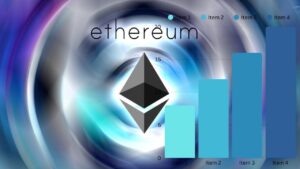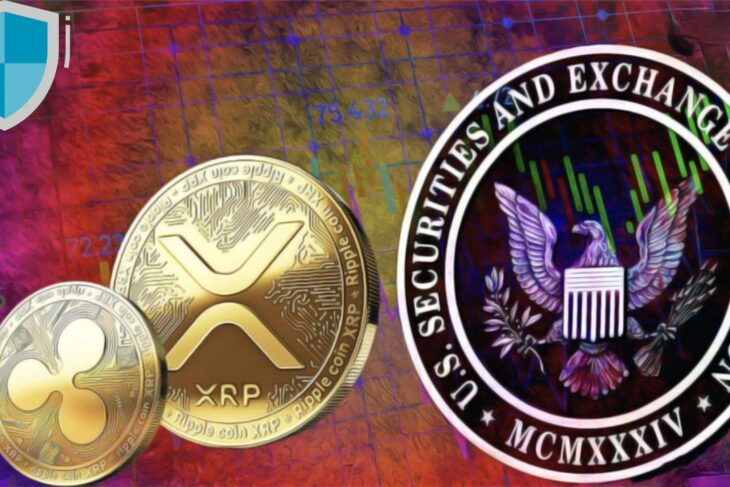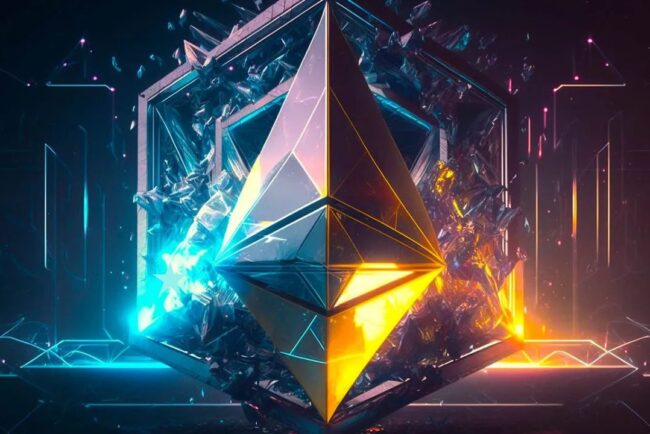
What is Ethereum ?
ETH is an open-source, public, blockchain-based distributed computing platform and operating system featuring smart contract (scripting) functionality.
Key Highlights:
- Developed by Vitalik Buterin and a group of developers in 2015.

- Ethereum isn’t just a cryptocurrency, it’s an actual programmable blockchain.
- Its own currency, Ether (ETH), is used for payments in transactions and computations.
Beginner View:
- View Ethereum as a worldwide computer that lets anyone run apps on the side even if you don’t own the server.
- While Bitcoin is (for payments, at least), Ethereum is the platform behind apps like DeFi, NFTs, games, and DAOs.
Advanced View:
- ETH has global code executing feature called EVM (Ethereum Virtual Machine).
- Given the network’s congestion and the cost of execution the gas fees, and the complexity of the smart contract increase and go down respectively.
- Since The Merge (2022), ETH became an environmentally friendly cryptocurrency by switching from PoW to PoS.
The Ethereum Blockchain ?
The ETH blockchain functions like a public ledger that logs all the transactions and smart contracts that take place in blocks.
How It Works:
- Each transaction, smart contract and dApp interaction are logged to the blockchain.
- Miners (currently validators in PoS) validate these transactions.
- Blocks are stacked in a linear/time sequence.
Beginner View:
- Imagine an open notebook that everybody has access to, in which nobody can not write, but nobody can erase.
Advanced View:
- Ethereum scale effectively through layer-2 solutions (like Arbitrum, Optimism).
It makes possible accounting token standards such as ERC-20 (for crypto tokens) and ERC-721 (for NFTs).
3. Ethereum Mining (Now Staking) ?
Prior to 2022, ETH was based on Proof-of-Work and had to be mined. After the Merge, Ethereum operates on Proof-of-Stake.

Previous System (Mining – prior to 2022)
Computers with heavy-duty processors were racing to solve puzzles to add new blocks.
About energy and raw dog-knuckle competitiveness with energy.
New System (Staking – now) Users “stake” E.T.H. to become validators.
New blocks are verified and appended to blockchain by choosing validators in random.
Much more energy-efficient.
Beginner View:
- Staking is similar to locking up some ETH to support the system and receive rewards in exchange.
Advanced View:
- Validators will have to stake 32 ETH or provide their stake through staking pools.
- There is a punishment involved slashing malicious validators.
4. Ethereum Keys and Wallets ?
To use ETH, you need an ETH wallet to manage your public and private keys.
1. Public Key:
- Things like your bank account number.
- You can paste it anywhere you want to share it to get ether.
2. Private Key:
- Like your password or PIN.
- NEVER share it — anyone who owns it owns your ETH.
3. Wallet Types:
- Hot Wallets (MetaMask, Trust Wallet): Online, easy to use but not as secure.
- Cold Wallets (Ledger, Trezor): Offline, ideal for long-term safety.
Beginner Tips:
- Remember to back up and secure your Seed Phrase.
- For significant sums of ETH, employ hardware wallets.
Advanced Tips:
- Make use of multi-signature wallets for team / org control.
- Think about smart contract wallets (AKA Argent) with programmable security.
5. Ethereum Security ?
Security is crucial in the Ethereum ecosystem, especially with the rise of DeFi, DAOs, and NFTs.

1. Security Basics:
- ETH is very secure, but smart contracts not so much.
- Most losses stem from hacks, phishing or code bugs, the report said.
2. Best Practices:
- Never reuse seed phrases.
- Invest in hardware wallets and set up 2FA.
- Verify smart contract audits prior to engaging with dApps.
3. Advanced Security:
- Formal verification of smart contracts is a must.
- Test your contract on testnets such as Goerli, Sepolia before real deployment on mainnet.
- Be aware of reentrancy, oracle abuse, and front-running.
6. The History of Ethereum (2008–2025)
Introduction –
ETH, often called the “world computer,” has had a fascinating journey since its inception. While Bitcoin set the stage for decentralized digital money, Ethereum built a decentralized world around it—powering smart contracts, NFTs, and DeFi ecosystems.
From whiteboards to billion-dollar apps, this timeline helps tell the Ethereum story, in five-year increments from 2008 to 2025, with price cycles, groundbreaking moments and real-world effects.
2008–2013: The Pre-Ethereum Era
- 2008: Satoshi Nakamoto publishes Bitcoin’s whitepaper.
- ETH did not yet exist, but the foundations for it were being laid in the earliest days of blockchain research.
- Frustrated with what he saw as Bitcoin’s limited scripting language, a young programmer named Vitalik Buterin, who co-founded the cryptocurrency Due to that frustration, a young programmer named Vitalik Buterin, one of the co-founders of the cryptocurrency Ethereum, set out in 2013 to create a new platform.
The Spark of an Idea:
In 2013, Vitalik’s idea was a new blockchain that could host decentralized apps rather than just transactions. Ethereum was conceived as a project to generalize and expand on Bitcoin’s features into something beyond just a currency.
2014–2015: Ethereum Is Born.
- 2014: Publication of Ethereum’s whitepaper.
- A $18m crowdsale is conducted selling ETH for ~$0.30 per token.
- ETH Development “Ethereum Foundation is established in Switzerland to oversee development.
Key Launch:
- July 30, 2015: ETH mainnet launches.
- First block reward: 5 ETH per block.
- Price: Up to $1.50 through 2015.
Case Study:
Early adopter’s mostly swarmed to ETH to create DAPPs which saw early games, escrow services and DEDCENTRALISED AUTONOMOUS Organisation’s.
2016–2018: Explosive Growth and the DAO Hack.
2016 Highlights:
- The first big ETH app, The DAO, raises $150M in ETH.
- A hacker exploits a bug, siphoning $60M, inciting panic.
- ETH hard forks to become:
- Ethereum (ETH) – the split chain
- Ethereum Classic (ETC) – This is the chain that was never nullified.
Price Trend:
- Jan 2016: ~$1
- June 2016: ~$21
- Post-hack dip: ~$7
- Recovery in 2017
2017–2018 Bull Market:
- Triggered by ICO mania (Initial Coin Offerings) settled on Ethereum.
- The rise of ETH to over $1,400 on Jan 2018.
- ETH is the default for new startups in crypto.
Case Study:
The likes of EOS, TRON and Status raked in billions of ETH in ICOs. But many of them either failed, or were scams, which helped lead to a crash in 2018.
2019–2020: Bear Market and Building Years
- 2019:Early 2019 and Eth price is back around ~$85.
- But developers kept building.
- Ethereum 2.0 Roadmap (Proof-of-Stake, Sharding) formally unveiled.
2020:
- The emergence of DeFi:
- Platforms like Uniswap, Compound and Aave roaring.
- ETH as a collateral, liquidity, and governance.
Price Trend:
- Jan 2020: ~$130
- Dec 2020: ~$730
Key Events:
- Implementation of ETH 2.0 Phase 0 (Beacon Chain) in December 2020.
Case Study:
2020 also saw the rise of Yield Farming, where users were incentivized to lock ETH with in DeFI protocols to earn rewards. Yearn Finance (YFI) and SushiSwap were just two of many examples of extremely quick experimentation.
2021–2022: Bull Run and The Merge
- 2021:ETH hits $4,800 in November.
- NFTs explode—Ethereum hosts CryptoPunks, Bored Ape Yacht Club, and more.
- Network congestion drives gas fees over $100 per transaction at peak.
2022:
- Market correction hits. It would not; ETH drops to below $1,000 mid-year.
- September: The Merge to Proof-of-Work The Merge successfully migrates ETH from PoW to PoS.
- Hidonglord DMIFu DTEngery consumptuin is reduced by ~99.95%.
Case Study:
The Merge of Ethereum was compared to “swapping the engine of a moving car.” It occurred without a single hiccup, proving the technical strength and development dynamism of Ethereum.
2023–2025: The Rollup Era and Real-World Adoption
2023:
- Ethereum scales through Layer 2 solutions such as:
Arbitrum, Optimism, Base - Gas fees get more affordable.
- ETH price reclaims ~$1,800–$2,100 band.
2024:
- Danksharding is the push for an ETH scaling upgrade in order for data availability to be less expensive.
- Real-world asset tokenization continues to gain momentum:
- nstitutions start using ETH for bonds, stablecoins and CBDCs.
Price Trend (estimates based on momentum):
- Early 2024: ~$2,000
- Mid-2025 (projected): $3,500–$5,000 depending on uptake and oversight
Case Study:
JPMorgan and Siemens made tokenized bonds on ETH sidechains in the year 2024 – which goes to show that traditional finance and decentralized systems are colliding.
The Ethereum Price from 2008 to 2025.
| Year | Event | ETH Price Range |
|---|---|---|
| 2014 | Crowdsale Begins | $0.30 |
| 2016 | DAO Hack | $1–$21 |
| 2017 | ICO Boom | $10–$1,400 |
| 2018 | Crash | $1,400 → $85 |
| 2020 | DeFi Summer | $130–$730 |
| 2021 | All-Time High | $4,800 |
| 2022 | The Merge | $1,000–$1,600 |
| 2024 | Institutional Growth | $2,000–$3,000 |
| 2025* | Scaling & Adoption | $3,500+ (proj.) |
Final Thoughts
ETH has endured hacks, crashes, criticism and challenges from rival networks. What started out as a programmable blockchain concept has become a foundational layer for decentralized finance, gaming, AI and tokenized assets.
“With ETH scaling on Layer 2s and upgrading via sharding, we have so many more ecosystems and possibilities than we did just a few months ago, and just a year ago. From $0.30 to trillion dollar asset class, the Ethereum journey is just getting started.
7. Pros And Cons
Pros of Ethereum:
- It is smart contracts that allow one to execute a logic on a certain decentralized network.
- Robust developer community and ecosystem.
- Supports NFTs, DeFi, DAOs, among others.
- The World’s database without censors.
- Introduction of PoS has made energies greener.
Cons of Ethereum:
- During times of congestion, gas fees can be quite high.
- SLOWER THAN SOME COMPETITORS Such as Solana or Avalanche.
- But it is still hobbled by scalability and UX challenges.
- Learning curve for beginners.
8. FAQs
Q1: Is Ethereum the same as Bitcoin?
No, Bitcoin is a digital currency, Ethereum is a DAPPS, Smart contracts and programmable money platform.
Q2: How do I buy Ethereum?
ETH is available for purchase on exchanges like Coinbase, Binance and WazirX, for fiat or other cryptocurrencies.
Q3: Is Ethereum safe?
Yes, if used properly. Ethereum is secure, but you’re still responsible for your wallet and not getting scammed by dApps.
Q4: What is gas in Ethereum?
Gas is the charge in Ethereum required to do a transaction or execute a contract.\usepgfplotslibraryforest.
Q5: Can Ethereum be used for NFTs?
Absolutely. The leading blockchain for NFTs is ETH using the ERC-721 and ERC-1155 token standards.
Q6: Will Ethereum fees ever drop?
Yes. With Layer 2 and ETH upgrades scaling solutions such as Danksharding, gas prices are expected to come down a lot.
9. The Bottom line ?
ETH is more than a cryptocurrency; it’s an open source blockchain based platform that allows developers to build and deploy decentralized applications (dApps).
If you are a novice who wants to get your first ETH, or an experienced developer who wants to run their own smart contracts, ETH has plenty for you – from limitless opportunities that one can explore, but with great power comes great responsibility and it demands you to be aware, cautious and updated.
Pro Tip –
Tip – Begin small, only use secure wallets and keep yourself informed. ETH is the future — but it’s also a work in progress, so navigate it wisely.
“Thank You “











One thought on “Lets know about it Ethereum now”